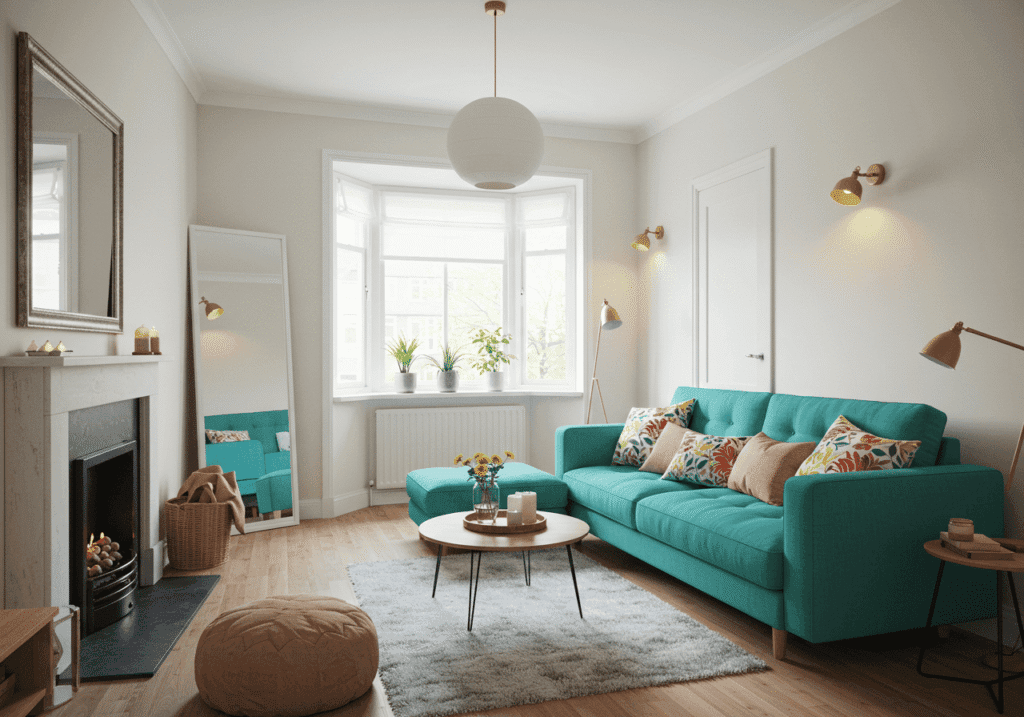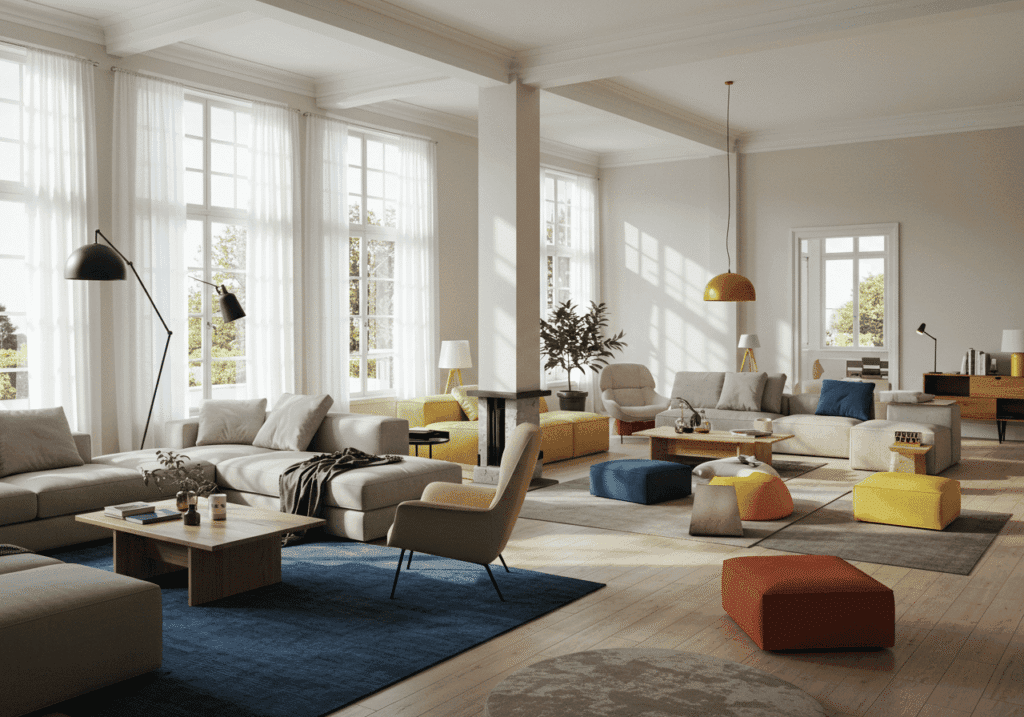Working with a small living room doesn’t mean sacrificing style or comfort. In fact, some of the most stunning spaces I’ve seen are compact living rooms that feel incredibly spacious and inviting. The secret isn’t adding square footage—it’s using clever design tricks that fool the eye and maximize every inch.
Whether you’re dealing with a studio apartment, a cozy cottage, or just want to make your current space feel more open, these small living room ideas will transform how your room looks and feels. Get ready to discover how strategic choices in color, furniture, and layout can make your space feel like it doubled in size overnight.
1. Embrace Light Colors as Your Foundation
The fastest way to open up a small space is through your color palette. Light, neutral colors reflect more light and create the illusion of expanded walls. Think soft whites, warm creams, pale grays, and subtle beiges as your base.
This doesn’t mean your room has to feel bland or boring. You can still add personality through textures, patterns, and carefully chosen accent colors. The key is keeping your largest surfaces—walls, major furniture pieces, and flooring—in lighter tones.
Consider painting your walls and trim the same light color to eliminate visual breaks that can make walls feel closer. This seamless approach creates a continuous flow that tricks the eye into seeing more space than actually exists.
2. Master the Art of Strategic Lighting
Lighting is absolutely crucial for creating a bright living room that feels spacious. Dark corners make any room feel smaller and more cramped, so your goal is to eliminate shadows and create even illumination throughout the space.
Layer your lighting with three types: ambient (overhead or general lighting), task (reading lamps or focused lighting), and accent (decorative or mood lighting). This combination ensures no corner feels forgotten or dim.
Don’t rely on just one overhead fixture. Instead, place lamps at different heights around the room to create pools of light that draw the eye around the entire space. This movement makes the room feel more dynamic and larger.
3. Choose Furniture with Exposed Legs
One of my favorite space-saving decor tricks is selecting furniture that sits up on legs rather than pieces that touch the floor. When you can see underneath furniture, it creates the visual impression of more floor space, which makes the entire room feel less crowded.
Look for sofas, chairs, coffee tables, and storage pieces with visible legs. Even a few inches of space underneath makes a significant difference in how open your room feels.
This principle extends to your living room ideas overall—the more floor you can see, the more spacious your room will appear. It’s a simple change that delivers dramatic results.
4. Use Mirrors to Double Your Space (Visually)
Mirrors are like magic for small spaces. They reflect light, create depth, and can literally make your room appear twice as large. The key is placing them strategically to maximize their impact.
Position a large mirror across from a window to reflect natural light and outdoor views back into the room. This creates the illusion of an additional window and brings more brightness into your space.
You can also use multiple smaller mirrors to create a gallery wall effect, or choose mirrored furniture pieces like coffee tables or side tables to add reflective surfaces throughout the room.
5. Optimize Your Furniture Layout for Flow
The way you arrange your furniture can make or break the spacious feeling you’re trying to achieve. Instead of pushing everything against the walls, try floating some pieces to create distinct zones and improve traffic flow.
Pull your sofa away from the wall and create a conversation area with chairs and a coffee table. This actually makes the room feel larger because you’re using the vertical space more effectively and creating depth. For more inspiration on effective arrangements, check out these beautiful living room layouts that maximize space.
Keep pathways clear and wide enough to move through comfortably. Cramped walkways make any space feel smaller, while open pathways create a sense of flow and spaciousness.
6. Go Vertical with Your Storage and Decor
When floor space is limited, think up! Using your wall space effectively draws the eye upward and makes ceilings feel higher while providing essential storage and display areas.
Install floating shelves that go all the way up to the ceiling, hang artwork higher than you might normally, and use tall, narrow bookcases or storage units. This vertical emphasis creates the illusion of height and makes your room feel more expansive.\
For additional clever storage solutions that won’t overwhelm your small space, explore these storage and organization ideas that blend seamlessly with your decor.
7. Choose Multi-Functional Furniture Pieces
In a small living room, every piece of furniture should work overtime. Look for pieces that serve multiple purposes to reduce clutter and maximize functionality without sacrificing style.
Ottoman storage benches provide seating and hide blankets or games. Nesting tables can be pulled out when needed and tucked away when not in use. Console tables behind sofas offer display space and storage while defining the seating area.
A coffee table with lower shelf storage, side tables with drawers, and sofas with built-in storage all contribute to a cleaner, more organized space that feels significantly larger.
8. Create Continuity with Your Flooring
If possible, use the same flooring throughout your small living room and adjacent spaces. This continuity eliminates visual breaks that can make spaces feel chopped up and smaller than they are.
If you’re renting or can’t change the flooring, use large area rugs to create this same effect. Choose a rug that’s large enough to anchor all your main furniture pieces, which helps define the space while creating visual cohesion.
Avoid small, scattered rugs which can make a space feel fragmented. One large rug is always better than several small ones for creating the illusion of more space.
9. Minimize Visual Clutter Through Smart Styling
Clutter is the enemy of spacious-feeling rooms. The more stuff visible in your space, the more cramped it will feel. This doesn’t mean your room has to be stark or unwelcoming—it means being intentional about what you display.
Choose a few larger decorative pieces rather than many small ones. Group items in odd numbers, and leave plenty of breathing room between objects. Use closed storage to hide everyday items that don’t contribute to your room’s aesthetic.
Apply the “less is more” principle to your wall decor ideas as well—a few impactful pieces will make more visual impact than a crowded gallery wall in a small space.
10. Use Transparent and Reflective Materials
Incorporate furniture and decor made from glass, acrylic, or other transparent materials. These pieces provide function without visual weight, making your room feel less crowded while still meeting your needs.
A glass coffee table, acrylic side tables, or transparent desk chairs allow light to pass through and don’t block sightlines across the room. Metallic finishes on lamps, picture frames, and accessories also add reflective surfaces that bounce light around.
Even small touches like glass table lamps or metallic picture frames contribute to the overall brightness and openness of your space.
11. Bring the Outdoors In
Plants and natural elements can actually make a small room feel larger by adding life and connecting your interior to the outdoors. The key is choosing the right plants and positioning them strategically.
Tall plants in corners draw the eye upward and add vertical interest. Hanging plants save floor space while adding greenery. Even small plants on shelves or tables contribute to the fresh, open feeling you want to achieve.
Natural light from windows is your best friend, so keep window treatments minimal and allow as much light in as possible during the day.
12. Define Zones Without Walls
In a small space, you might need your living room to serve multiple purposes—relaxation, work, dining, or entertainment. Create distinct zones without adding walls that would make the space feel smaller.
Use furniture placement, area rugs, or lighting to define different areas. A console table can separate a living area from a dining space, while a floor lamp can create a cozy reading nook in a corner.
This approach gives you the functionality you need while maintaining the open, airy feeling that makes small spaces work beautifully.
Transform Your Small Space Into Your Favorite Room
Making a small living room feel bigger and brighter isn’t about expensive renovations or major construction. It’s about understanding how design elements work together to create the illusion of space and implementing these strategic changes thoughtfully.
Start with one or two of these small living room ideas that appeal most to you, then gradually incorporate others as you find pieces that work with your budget and style. Remember, the most beautiful rooms aren’t necessarily the largest ones—they’re the ones that feel perfectly proportioned and thoughtfully designed.
Your small living room has incredible potential to become the most inviting, functional space in your home. With these designer tricks in your toolkit, you’re ready to create a room that not only looks bigger and brighter but feels like the perfect reflection of your personal style.
For more inspiration to transform every room in your home, explore our complete collection of decorating ideas at Pretty Home Finds.

